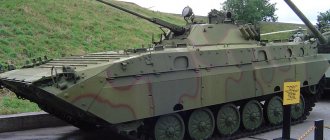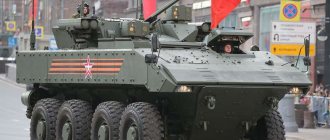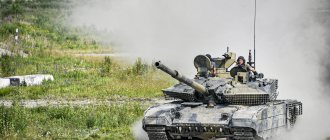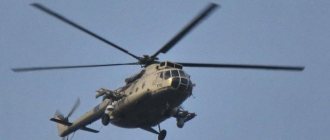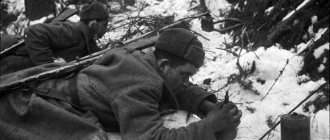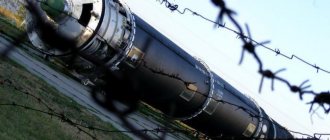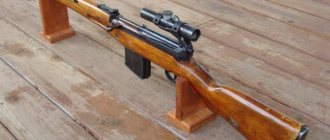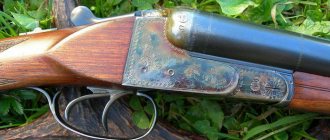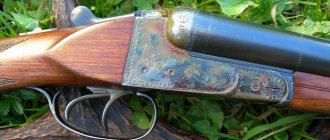Russia may develop a light wheeled tank based on the Boomerang platform. Andrei Krasovitsky, general director of Voenno-Industrial, stated this in an interview with the Zvezda TV channel. What is special about the Boomerang and how Russia has already tried to create wheeled tanks - in the material of the iz.ru portal.
“Our plans are to make a wheeled tank today. This will be such know-how. On the same platform ["Boomerang"], but it will be a cannon of a larger diameter. And we will be able to talk about this in the near future,” Krasovitsky said.
Promising wheeled
VPK-7829 "Boomerang" is a universal wheeled platform, one of three promising platforms on which the Russian army will build armored vehicles from the 2020s. The other two are the medium tracked Kurganets-25 (on which the B-11 infantry fighting vehicle is being created) and the heavy Armata. The latter, in particular, created the T-14 tank and the T-15 heavy infantry fighting vehicle.
BTR "Kurganets-25"
BTR "Kurganets-25"
Photo: RIA Novosti/Vadim Savitsky
For the first time, the platform was openly shown during training for the Victory Parade in 2015; before that, it was demonstrated in the closed part of the Russia Arms Expo 2013 exposition in Nizhny Tagil. According to the initial plans of the State Armaments Program 2011–2020, serial equipment created on all three platforms was supposed to go into service with the troops starting in 2015. However, testing and improvements were delayed.
The expert called the Russian project of a tank on wheels unique
Based on the Boomerang, a whole family of wheeled combat vehicles was proposed. The most famous are the K-17 BMP and the K-16 BTR.
The first vehicle, the “base” one in the family, is equipped with the Boomerang-BM uninhabited combat module, developed at the Tula Instrument Design Bureau. The module includes a 30-mm 2A42 automatic cannon, a 7.62-mm PKTM machine gun, and two dual launch containers for Kornet-D guided missiles. The latter can be used against ground targets (missile with thermobaric equipment), against armored vehicles (with tandem cumulative equipment) and against low-flying air targets with speeds of up to 250 m/s (missile with high-explosive fragmentation equipment). Anti-tank missiles are used at a range of up to 8 km, missiles against unprotected ground and air targets - up to 10 km. The K-16 armored personnel carrier carries an uninhabited combat module, created at the Burevestnik Central Research Institute, with a 12.7-mm Kord machine gun stabilized in two planes.
Boomerang
BTR "Boomerang"
Photo: IZVESTIA/Alexey Mayshev
Krasovitsky: the armored personnel carrier "Boomerang" is space technology
General Director of the Military Industrial Company - about the prospects of Russian armored vehicles
Subsequently, other configuration options for the Boomerangs were noticed. In particular, at the show of armored vehicles at the Army 2017 forum, a version with a manned fighting compartment, Berezhok, was shown. This solution was also developed in Tula to modernize the Soviet BMP-2 fleet. The module includes a 30-mm 2A42 automatic cannon, two dual containers for Kornet missiles and a 30-mm AG-30M automatic grenade launcher. The latter is a low-ballistic fire weapon and is designed to hit manpower along an overhead trajectory, hiding in the folds of the terrain.
In all these variants, the vehicle, driven by a crew of three, is capable of carrying eight paratroopers.
"Centaurs" did not take root
Five years ago, the Ministry of Defense was working on the issue of equipping the Russian Armed Forces with the Italian Centauro wheeled tank, but things did not go further than testing.
Testing of the two vehicles began in 2012 and was carried out in Kubinka, near Moscow, at the training ground of the Research Testing Institute of the Russian Ministry of Defense. One of these wheeled tanks was equipped with a 105 mm caliber gun, and the other - 120 mm. In January 2013, the purchase was abandoned and the contract was suspended. As Colonel General Vladimir Chirkin noted, then the commander-in-chief of the Ground Forces, “these combat vehicles have certain advantages, but there are also many disadvantages: they were overly advertised - not everything fits.”
| The first prototype of the new Italian wheeled gun armored vehicle CIO Centauro II MGS 120/105. |
| Source: CIO |
According to open sources, the Centaur, weighing 25 tons and equipped with a 105 mm gun, can reach speeds of up to 100 km/h. Power reserve - 800 km. There are three people in the crew. Experts note the high maneuverability and good controllability of these vehicles, but their armor only protects them from heavy machine gun fire. In turn, the Centauro developers note that the wheeled tank's cannon provides the same firepower as most legacy main tanks.
At the International Exhibition of Arms and Military Equipment of the Ground Forces Eurosatory 2016, the Centauro II MGS 120/105 armored vehicle was presented - an improved version of the previous armored wheeled version. The update concerned the replacement of the main type of weapon from a 105 mm gun to a 120 mm gun.
The tanks are produced by the Iveco-Oto Melara consortium. The vehicles are in service with Italy, Spain and Oman. Centauro was used, in particular, in Yugoslavia, Somalia and Iraq, and was used as part of the UN military contingent in Lebanon. At the same time, vehicles participating in peacekeeping operations in the Balkans were equipped with additional armor.
As experts note, this technology is especially interesting because there are no vehicles of this class in the Russian army, although the development of such platforms was carried out back in Soviet times.
Light gun
This is not the first attempt to “sell” a light tank, including a wheeled one, to the Russian army. In the late 2000s, the 2S25 Sprut-SD airborne self-propelled gun, which is a 125-mm tank gun on a BMD-4 chassis, was developed for the needs of the Airborne Forces. The main purpose of such a vehicle is to destroy tanks and heavy fire support weapons. The vehicle was produced in small quantities and did not take root among the troops.
Sprut-SD
Sprut-SD airborne self-propelled anti-tank gun
Photo: RIA Novosti/Mikhail Voskresensky
"Boomerang" for all trades
A whole family of specialized vehicles has been created based on the latest wheeled chassis
Even earlier, in the early 1970s, the USSR developed a wheeled anti-tank self-propelled gun with an 85-mm cannon (2S14 “Sting-S”) based on the BTR-70 for use in the battalion level. However, by the time the tests were completed (1980), the caliber of the gun was already recognized as insufficient to combat enemy main battle tanks and, moreover, did not allow the development of guided ammunition for it.
Russia actually tried to acquire a wheeled light tank on the foreign market. In December 2010, it was decided to conduct tests in Russia of two Italian combat vehicles - the B1 Centauro tank destroyers and two VBM Freccia armored personnel carriers (based on them). Tests took place in 2012 at the training ground of the 38th Research Institute of the Ministry of Defense, and this area was considered competitive with the “Boomerang” theme.
VBM Freccia
VBM Freccia
Photo: Wikipedia.org
Subscribed for 10 years
What is the focus of the new state weapons program approved for 2018-2027?
Tanks equipped with 105 mm and 120 mm OTO Melara guns were considered. The armored personnel carriers were tested in versions with 25 mm and 30 mm automatic cannons. If the equipment were approved by the military, then it was planned to organize its assembly production in Russia - by analogy with the Lynx armored vehicles (Italian IVECO LMV), which are still assembled.
However, the military rejected the “centaurs” and in the summer of 2014 announced that they would purchase Russian models in a similar class. As was reported privately, the vehicle, despite the noted advantages in terms of ease of use, smooth operation and weapon accuracy, performed disgustingly in operation in the autumn-winter period.
Why do drivers get wrong fines?
The Smolensk prosecutor's office has already sent instructions to Smolenskavtodor to eliminate the violations, it follows from the inspection materials. The State Traffic Safety Inspectorate in the Smolensk region has sent a demand to stop using the complex until it passes all the necessary checks and receives the relevant documents. The inspection materials were sent to Rosstandart for subsequent prosecution of officials under Art. 19.19 of the Administrative Code (“Violation of the legislation on ensuring the uniformity of measurements”; fine up to 100 thousand rubles).
In addition, the prosecutor's office saw signs of crimes under Art. 293 of the Criminal Code (“Negligence”) and Art. 286 of the Criminal Code of the Russian Federation (“Exceeding official powers”). The corresponding report was sent by the prosecutor's office to the Ministry of Internal Affairs for Smolensk and the Investigative Directorate of the Russian Federation for Smolensk.
The prosecutor's office of the Smolensk region assured Kommersant that the Boomerang complex is not currently in use. “Citizens can independently contact the traffic police or the court with a demand to cancel the administrative penalty in the form of a fine recorded by these video recording devices,” explained the press service of the regional prosecutor’s office. The State Traffic Inspectorate did not confirm the shutdown of the Boomerang complex. “During the consideration of the prosecutor’s submission, it was established that officials of the State Traffic Safety Inspectorate of the Russian Ministry of Internal Affairs for the Smolensk Region did not commit any violations of the current legislation of the Russian Federation,” says the commentary provided by the State Traffic Safety Inspectorate to Kommersant’s request.
Design[edit]
Rear view of the Bumerang with two water cannons visible
MIC says it "will be nothing like any current APC." The Bumerang vehicle will be based on the Armata universal combat platform. It will be amphibious and will be able to overcome water obstacles with the help of two water cutting machines. In flight with the previous armored personnel carrier (Like the BTR-70), the engine will be located at the front, not at the rear. A significant drawback of the armored personnel carrier was the location of the engine, when soldiers had to exit the vehicle through cramped side doors. The Bumerang has rear doors and roof hatches for troop entry and exit. It will likely have a three-person crew consisting of a driver, gunner and commander, and accommodate seven troops. Protection will be provided by ceramic armor and technologies to prevent projectile fragments. Like the APC, the Boomerang will be an 8×8 wheeled vehicle, and will be equipped with 750 hp. turbocharged diesel engine.
One of the main developing areas in the global market for armored combat vehicles in recent years is the design, development and procurement of wheeled armored fighting vehicles with an 8x8 wheel arrangement and, to a lesser extent, armored fighting vehicles with a 6x6 wheel arrangement.For example, Belgium decided to remove from service all tracked armored fighting vehicles, including tanks and tracked armored infantry fighting vehicles, and replace them with wheeled armored personnel carriers Piranha III and its variants manufactured by MOWAG (Switzerland). A number of other countries have demonstrated a similar approach to this problem.
However, most countries follow the path of a balanced approach to the fleet of wheeled and tracked armored fighting vehicles, since they complement each other and each type of vehicle has its own inherent advantages and disadvantages.
Wheeled vehicles have a higher level of strategic mobility and require lower operating and maintenance costs, but have a lower level of protection and firepower.
Their tracked counterparts have a higher level of protection, firepower and tactical mobility, but they tend to weigh more and require the use of vehicles to transport heavy military equipment when transported over long distances.
In recent years, the total weight of 8x8 armored fighting vehicles has increased significantly. The newest examples of such armored fighting vehicles vary in weight - from 22 tons to 33 tons (Boxer machine, manufactured by ARTEC). For comparison, the first sample of the LAV-25, produced by General Dynamics Land Systems-Canada (GDLS-C), had a mass of 13 tons. The LAV-25 is still used by the US Marine Corps today. It was first tested in 1983. and since that time has become widespread throughout the world.
Even vehicles that have recently undergone field testing, such as the GDLS-C Stryker infantry fighting vehicle, have seen a significant increase in overall weight due to additional armor and other subsystems. Such modifications became necessary as a result of experience gained in operations in Iraq and Afghanistan.
Today, users place a number of additional increased demands on wheeled combat vehicles. This typically refers to parameters such as capacity, load capacity and level of protection against various threats. It is common practice to increase firepower using turrets, remote-controlled weapon stations, and increased electrical power requirements due to the installation of air conditioning, remote-controlled weapon station, auxiliary communications equipment and electronic devices to counter the explosion of improvised devices.
Since modern machines have a significantly longer service life, users have a number of key requirements for future developments. These include expanding the functionality of the machine; electronic architecture that allows for easy upgrades, modular defense systems including Defense Assets Suite (DAS), new drive systems such as hybrid electric drives that provide cost-effective and reliable operation; new suspension systems such as hydropneumatic systems and active systems, ease of lifetime maintenance and built-in training tools.
Until recently, one of the main requirements placed by users on a car was that it should be floating. Therefore, some countries have purchased a small number of armored personnel carriers (8x8) for amphibious operations. These countries include Brazil (Piranha IIIC), Portugal (Pandur II) and Spain (Piranha IIIC).
However, although this feature remains required in some countries, most users do not consider it required. Canada, for example, provides a choice when modernizing its armored vehicles.
One of the requirements that some countries place on vehicles is that they can be transported by air on C-130 Hercules aircraft, although this requirement is not considered by users as a key factor. This is due to a number of reasons, not the least of which is the increase in the overall weight of the platforms due to the installation of additional armor.
There is an emerging trend associated with the purchase of new types of transport aircraft capable of carrying cargo of greater weight compared to previously used aircraft. Such new aircraft include, for example, the C17 Globemaster III, manufactured by Boeing, and the A400M transport aircraft, manufactured by Airbus Military.
Many of the most recent programs are characterized by the phased procurement of 8x8 vehicles. As a rule, the initial stage is a request for information followed by clarification and development of technical requirements. This is followed by the stage of comparative tests and, finally, the selection of a machine followed by the conclusion of a contract.
Many of the low-value contracts for 8x8 vehicles involved direct supply by the original manufacturer (OEM) of finished equipment. When purchasing large quantities of purchases, there were significant requirements for loading the capacity of local enterprises.
As a rule, the initial batch of machines comes from the manufacturer, and then the supply of components for assembling the machines on site is organized. The final stage is the organization of both the production of components and the final assembly of the machine. Typically, the OEM continues to supply some of the subsystems, such as the engine and transmission, that are expensive to manufacture under license.
However, local production or assembly often causes a number of problems related to quality control and delivery delays, with some of the orders being canceled or reduced.
Competition often arises related to the use of one or another combat module. A specific example is Denmark, which, before selecting the Lemur (formerly Bofors) remote-controlled weapon station, manufactured by BAE Systems Global Combat Systems, which underwent a large cycle of comparative tests with other remote-controlled weapon modules.
Now the Lemur combat module is installed not only on many Danish Piranha III 8x8 armored personnel carriers manufactured by MOWAG, but also on Eagle IV 4x4 reconnaissance vehicles, as well as on some support combat vehicles.
Poland has ordered 690 modular armored vehicles, known locally as Rosomak, manufactured by Patria Land & Armament. Many of these vehicles will be equipped with the HITFIST 30P turret manufactured by Oto Melara.
In addition, there is a steady trend of increasing the firepower of wheeled armored fighting vehicles.
Until recently, wheeled armored fighting vehicles were usually armed with a 7.62 mm or 12.7 mm machine gun, however, now an increasing number of countries operate vehicles with a double turret armed with a 25 mm cannon and a 7.62 mm coaxial machine gun.
